NVIDIA GeForce GTX 670 Review Feat. EVGA: Bringing GK104 Down To $400
by Ryan Smith on May 10, 2012 9:00 AM ESTAs always, we’re wrapping up our look at a video card’s stock performance with a look at power, temperature, and noise. As GTX 670 is a lower clocked, lower power, harvested version of GK104, it should do even better than GTX 680 here. Remember, the power target for GTX 670 is only 141W.
| GeForce GTX 600 Series Voltages | |||||
| Ref GTX 670 Boost Load | EVGA GTX 670SC Boost Load | Ref GTX 680 Boost Load | Ref GTX 670 Idle | ||
| 1.175v | 1.162v | 1.175v | 0.987v | ||
Stopping to take a quick look at voltages, we find that NVIDIA hasn’t really adjusted the voltages of GTX 670 compared to GTX 680. Because GTX 670 has a lower maximum boost bin than GTX 680 it ramps up to 1.175v a bit sooner, but otherwise it’s still covering the same range of voltages as opposed to having a lower max voltage to further improve the power consumption. EVGA however does just that, topping out at 1.162v. They’ll need all the power savings they can get since power consumption is inversely proportional to performance under NVIDIA’s power target system.
On that note before we jump into our graphs we wanted to try something new: a look at the average core clockspeed during our benchmarks. Because of GPU boost the boost clock alone doesn’t give us the whole picture – particularly when also taking a look at factory overclocked cards – we’ve recorded the clockspeed of our GPU during each of our benchmarks when running them at 2560x1600 and computed the average clockspeed over the duration of the benchmark.
| GeForce GTX 670 Average Clockspeeds | ||||
| GTX 670 | EVGA GTX 670SC | |||
| Max Boost Clock | 1084MHz | 1188MHz | ||
| Crysis | 1057MHz | 1079MHz | ||
| Metro | 1042MHz | 1066MHz | ||
| DiRT 3 | 1037MHz | 1062MHz | ||
| Shogun 2 | 1064MHz | 1105MHz | ||
| Batman | 1042MHz | 1075 MHz | ||
| Portal 2 | 988MHz | 1034MHz | ||
| Battlefield 3 | 1055MHz | 1080MHz | ||
| Starcraft II | 1084MHz | 1129MHz | ||
| Skyrim | 1084MHz | 1113MHz | ||
| Civilization V | 1038MHz | 1073MHz | ||
| OCCT | 953MHz | 980MHz | ||
In spite of the GTX 670’s boost clock of only 980MHz, we see that it spends almost its entire time above that, and indeed spends its whole time above the base clock. As far as games go, with the exception of Portal 2 it’s always in the mid-1000s, whereas the GTX 680 was only a bit higher at the high 1000s. This is a big part of why the GTX 670 has performed so well in our tests: it may be rated lower, but in fact it can reach clockspeeds very close to the GTX 680.
At the same time this is why we see the EVGA GTX 670 Superclocked struggle to separate itself from the reference GTX 670, in spite of a 6%+ factory overclock. Too much of the time it’s simply not boosting much higher than the reference GTX 670, which limits the performance gains. With GPU Boost in effect this means there are a range of cards and we could be looking at a particularly good reference GTX 680, but whether that’s the case or not the end result is that EVGA’s card can’t do too much amidst the 141W power target limit.
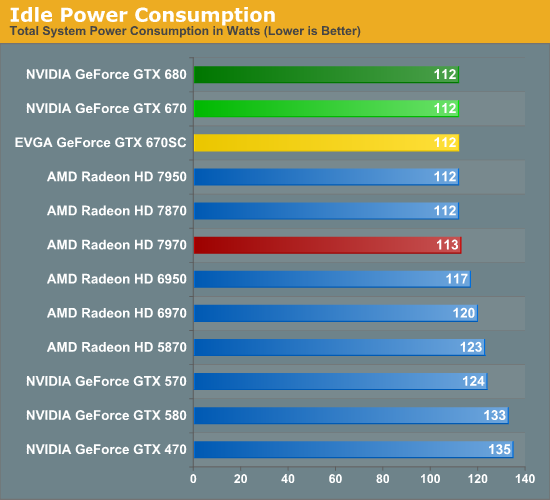
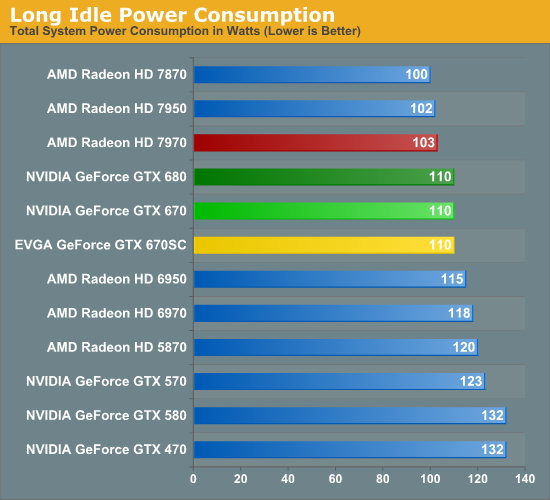
Starting with idle power, there aren’t any major surprised compared to the GTX 680. NVIDIA and AMD have both done such a good job managing their idle power consumption that even with the disabled SMX there’s no measurable difference between video cards. GTX 680 and GTX 670 effectively have the same idle and long idle power consumption.
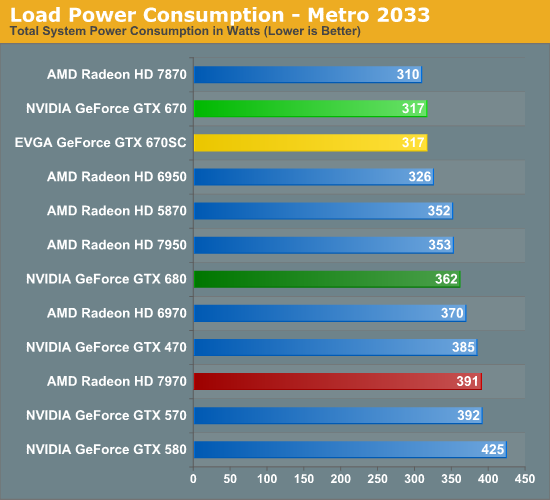
Moving on to load power consumption we can immediately see the GTX 670’s lower power target come into play. At 317W from the wall it’s 45W less than the GTX 680 for roughly 90% of the gaming performance, and this is in fact is lower power consumption than anything except the Radeon HD 7870. Even the GTX 560 Ti (which isn’t in this chart) is higher at 333W, reflecting the fact that GK104 is the true successor to GF114, and which would make GTX 670 the successor to GTX 560 from a design perspective.
Of course this also means that GTX 670 does very well for itself compared to AMD’s cards. We saw GTX 670 slightly outperform 7950 in Metro and here we see it drawing 36W less at the wall at the same time. Or compared to the 7970, 7970 can outperform GTX 670 by about 10%, but we’re drawing 74W more at the wall as a result.
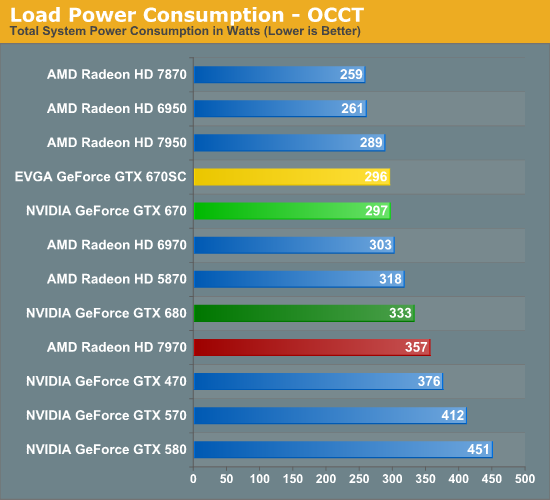
Relative power consumption shifts slightly under OCCT, but the story is otherwise similar. It’s not immediately clear why GTX 670’s power consumption is slightly higher than 7950 even after what we saw with Metro (PowerTune should be capping at 200W), but at least in this test the GTX 670 does end up doing a bit worse. On the other hand it’s still 60W less than the 7970.
Otherwise if we compare the GTX 670 to the GTX 680 we see that the GTX 680 ends up drawing 36W more at the wall, only a bit less than the difference we saw under Metro and quite close to what we’d expect based on the cards’ specifications.
On a related note, pay close attention to NVIDIA’s power target system in action here. In spite of the fact that the GTX 670SC is a binned part running at a lower voltage and higher clockspeeds, it’s drawing 1W less than the reference GTX 670. It would appear that NVIDIA has very good control over their power consumption overall, even if they can only adjust clocks for it a few times per second.
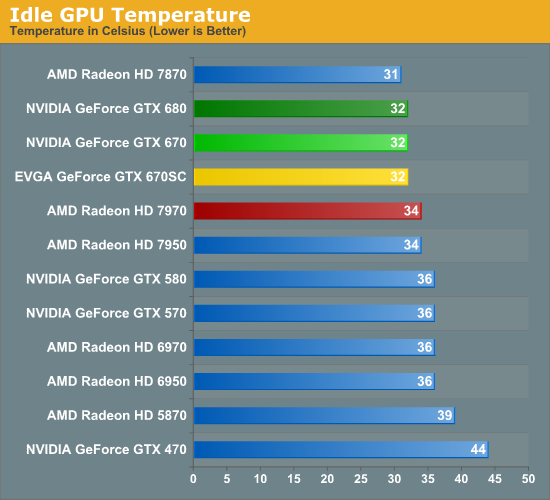
Seeing as how NVIDIA is using roughly the same cooler design with GTX 670 as they are with GTX 680 and they have the same idle power consumption, it should come as no surprise that temperatures are so similar. 32C is among the lowest of the temperatures we’ll see for a blower unless it’s running fast & loud.
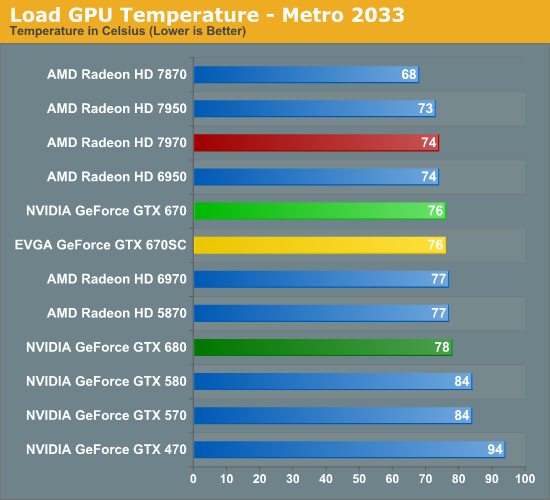
Thanks to the lower power consumption of the GTX 670 temperatures have gone down as well. 76C is still 2C warmer than the Radeon HD 7900 series due to AMD’s more aggressive cooler but it’s 2C cooler than the GTX 680. The thermal threshold for GK104 is 98C, which means there’s still over 20C of thermal headroom to play with here.

OCCT pushes temperatures up some, but not by much thanks to NVIDIA’s power target system. Since the GTX 680 tied the 7970 at 79C here, this means the GTX 670 is 2-3C cooler than both the GTX 680 and the 7970, and 0-1C warmer than the 7950.
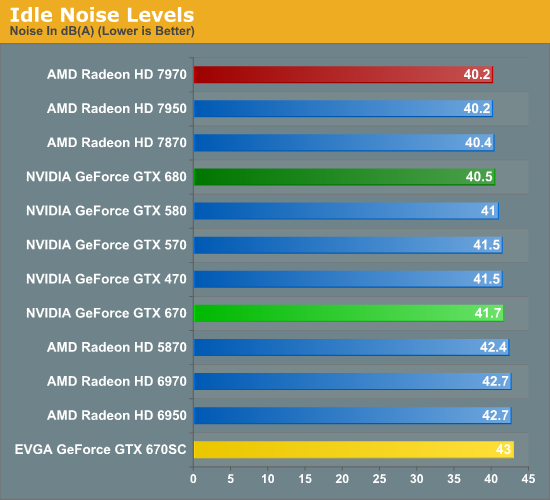
Unfortunately the impressiveness of the GTX 670 begins to wane some here at noise. NVIDIA tells us that the GTX 670 uses the same fan as the GTX 680 but this seems questionable. 41.7dB is not significantly louder than the GTX 680’s 40.5dB, but there’s a definite difference in pitch compared to the GTX 680. The GTX 670 seems to have a low pitch hum/grind to it that GTX 680 didn’t have.
Meanwhile EVGA’s card fares the worst here, at the precipice of falling out of the quiet zone. Since it’s using what’s fundamentally the same fan and cooler as the reference card, the only practical explanation is that EVGA’s smaller diameter fan intake has a negative impact on fan noise.
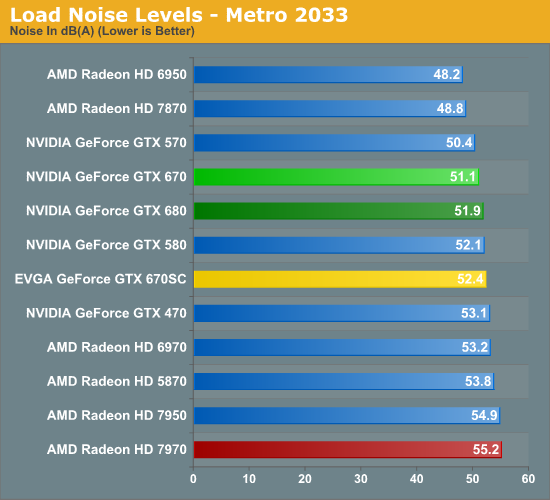
Finally, when looking at load noise we see that the GTX 670 doesn’t fare significantly better or worse than the GTX 680 here. At 0.8dB quieter than the GTX 680 the GTX 670 is a smidge quieter, but it’s nothing that’s particularly appreciable. Perhaps the more important fact is that this is 3.8dB quieter than the 7950 and 4.1dB quieter than the 7970, making the GTX 670 notable quieter than either 7900 series card. In practice the only place the GTX 670 loses is oddly enough to the GTX 570. The GTX 570 was 0.7dB quieter than the GTX 670 despite the former’s much higher power consumption. NVIDIA did let the GTX 570 get hotter than the GTX 670 so it looks like the GTX 670’s fan curve is a bit more aggressive than the GTX 570’s.
As for the EVGA GTX 670 Superclocked we’re seeing the same thing that we saw at idle: it’s just a bit louder than the reference GTX 670. This is in spite of the fact that the GTX 670SC’s fan actually went to the same speed as the reference GTX 670’s fan in this test.
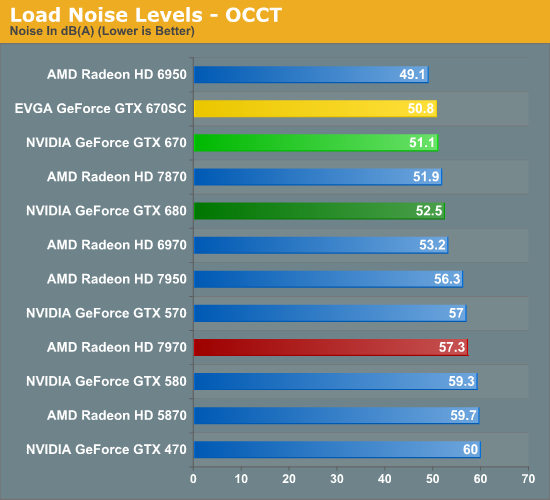
NVIDIA’s power target once more makes itself known here, thanks to which power consumption and thereby heat generation increases very little compared to what we saw under Metro. This widens the gap between the GTX 670 and 7900 series, which is now at 5.2dB and 6.2dB compared to the 7950 and 7970 respectively. Or compared to NVIDIA cards this is 1.4dB quieter than the GTX 680 and nearly 6dB quieter than the unthrottled GTX 570.
Meanwhile there’s something very interesting going on with the GTX 670SC that’s a wider reflection of the GTX 670’s reference fan. The fan speed went up but objective noise (A-weighted) went down. Why? That low-pitch hum we mentioned diminishes with a higher fan speed, and as a result the fan gets quieter once it passes a certain threshold. Subjectively we agree with our sound meter: the GTX 670SC sounds quieter here than it does as the lower fan speed it uses for cooling during Metro. We haven’t experienced anything like this with the GTX 680, which makes us further doubt that the fans are identical between the GTX 680 and GTX 670. Close no doubt, but not the same.
Wrapping things up this entire scenario is very similar to how we saw the launch of the GTX 680 play out. NVIDIA has a strong performing part with less noise and less power consumption than either its 500 series predecessors or AMD’s closest competition. This in turn was a big part of what made the GTX 680 so easy to recommend, as better performance with less noise is exactly the kind of direction we like to see video cards move in.










414 Comments
View All Comments
Morg. - Thursday, May 10, 2012 - link
No.I am saying that tahiti XT paired with 384 bits RAM AND clocked at the same speed as a gtx 680 paired with 256 bits RAM, has clearly more raw power.
The thing is, two years from now, nVidia will be boosting other new games for the NEW nVidia hardware and you will not benefit from it on the old H/W.
However, raw power will remain, 3GB of RAM will still be 3GB of RAM and you will thank god for the added graphics you get out of that last 1 GB that cost you nothing more.
The two games that have for years been GPU benchmarks and haven't been sponsored by either nVidia or AMD are Crysis warhead and metro 2033.
If you wanna trash those results because BF3 is everything to you, you should totally do it though.
scook9 - Thursday, May 10, 2012 - link
Crysis: Warhead is a "The way it is meant to be played" title.....You see that every time you start it up as well as on the box.
http://image.com.com/gamespot/images/bigboxshots/3...
eddman - Thursday, May 10, 2012 - link
Two years from now 7970 won't be powerful enough anyway.As scook9 mentioned, warhead is an TWIMTBP and yet runs better on 7970.
It'd be better if you removed that tin foil hat. TWIMTBP and Gaming Evolved are programs to help developers code their games better.
There are countless TWIMTBP games that run better on radeons.
Crysis and warhead use an old engine that isn't going to be used anymore. Nowadays they are just obsolete benchmarks.
Metro 2033 is a very nice game and I really liked it, but it's not that popular and has a proprietary engine. Most gamers don't care about such engine.
Frostbite, OTOH, matters because it belongs to a major publisher/developer which means we'll see many games based on it in the future.
SlyNine - Thursday, May 10, 2012 - link
I'm pretty sure a 4870 (basically a 6770) is powerful enough today, why wouldn't a 7970 be powerful enough by than.Just because an engine is going to be used anymore doesn't mean it isn't useful to gauge certain aspects of a videocard. Many engines that will be used are not even developed yet, some may push a card more like the Crytech engine did.
Crytech 2 is going to be used for MechWarrior online baby. (Im glad it used a good engine, and it looks like they are using it to good effect).
eddman - Thursday, May 10, 2012 - link
Because 3GB memory is for high-resolutions and high AA settings, and 2 years from now 7970 won't have enough power to run those games at those settings at good frame rates.That doesn't make sense. Card A might run max payne 1 twice as fast as card B, but what'd be the point.
No, mechwarrior online uses cryengine 3, not 2. Cryengine 2, that was used in crysis and warhead, is dead.
SlyNine - Saturday, May 12, 2012 - link
I meant CryEngine 3. not sure why I said 2.There is no proof that 3gigs wont be enough for high res by then. Yea maybe not (or maybe) with AA.
Besides you didn't say anything about running maxed out everything, you made a blanket statement that the 7970 wont powerful enough period.
That means that card A does something that card B cannot, depending on what that is it have an effect on engines that focus on certain things.
eddman - Saturday, May 12, 2012 - link
I meant 7970 won't have enough shader power 2 years from now, so 3GB won't help then either.Yes, everything maxed out with high AA. After all that's what large memories are for.
Obsolete engine is obsolete. Deal with it. Cryengine 2 won't be used in any other AAA game. It's gone.
SlyNine - Saturday, May 12, 2012 - link
A realtime engine will always tell you something about the card. Obsolete or not.If 3GB gives it some sort of advantage then it was worth it. In many games it's already showing an advantage at ultra high res.
Only you are saying the only use of large video cache is AA at ultra settings. But this is simply a questionable premise.
I really don't care if Cryengine 2 is used for a AAA game, or ever again. I still play Crysis. Furthermore I don't give a dam about AAA games, most of them are dumbed down for mass appeal.
CeriseCogburn - Monday, June 11, 2012 - link
At 7000X what rez is 3GB showing an advantage ?ROFL - desperation
theprodigalrebel - Thursday, May 10, 2012 - link
BF3 has sold 1.9 million copies worldwide.Metro 2033 has sold 0.16m copies worldwide
Crysis is an old game that I don't see (m)any people playing.
BF3 is also scheduled for three DLC releases (two this year, third next year).
I see a perfectly good reason why BF3 performance matters. You are speculating that the 7900-series will have great Unreal 4 performance. That's just silly since nobody knows anything about Unreal 4 performance yet.
The only thing I could find was Hexus.net reporting that nVidia chose the Kepler to demonstrate the Unreal 4 engine at the GDC.